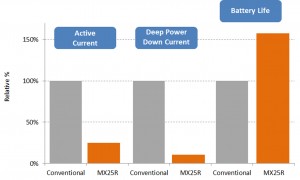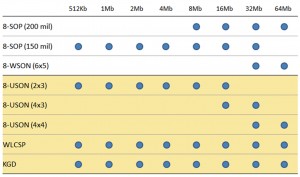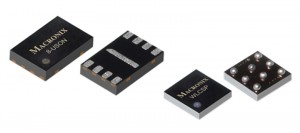Serial NOR Flash Memory Series MX25R Offers Ultra-Low Power and Wide Voltage Range
Macronix International Co. Ltd., a leading global vendor of non-volatile semiconductor memory devices, has recently introduced its new MX25R Serial NOR flash product family. The devices are specifically aimed at next-generation consumer wearables in the context of the ‘Internet of Things’ (IoT). The MX25R product family features an ultra-low-power mode and densities ranging from 512Kb up to 64Mb, with plans to move up to 128Mb, 256Mb and 512Mb in the near future. Power consumption in the MX25R family is 60 percent lower than traditional solutions, with a wide Vcc span of 1.7V to 3.6V to support diverse requirements of wearable devices. The new family fits within the Macronix portfolio of serial NOR flash products ranging from 512Kb to 1 Gb.
Serial NOR Flash Memory for Wearables
Macronix’s MX25R series caters specifically to next-generation consumer wearables. It supports the standard Serial NOR flash memory interface and industry-standard 8-pin layouts. With its very compact die, this allows for very small package dimensions such as the USON (Ultra Thin Small Outline No Lead), WSON (Very Very Thin Small Outline No Lead), WLCSP (Wafer Level Chip Scale Package), and also KGD (Known Good Die) solutions for stacked-die SIPs (System in Package).
The market prospects for wearables, in their first incarnations coming as sensor-enabled wristbands and rings, or smart watches equipped with fitness and location trackers, are a promising sub-segment of the IoT category of systems and services. According to new research from International Data Corporation (IDC), IoT systems and services promise a potential compound annual growth rate (GAGR) of 78.4 percent. By 2018 annual sales for wearables may exceed a total unit volume of 112 million units according to a recent report published by US market researcher IDC. This market dynamic has encouraged Macronix to develop novel product solutions of memory devices for wearable applications to further expand its leading position as a vendor of non-volatile memory devices.
“The key factor for wearables to gain rapid popularity is designing them with ultra-low power consumption and in a small form factor,” states Min-Cheng Lin, Deputy Director of Macronix’s Segment Marketing Department. “The next generation of memory devices will progress in the following directions: standardized interfaces prioritizing ease of data import, smaller and slimmer form factors and a power supply design focusing on ultra-low voltage and energy consumption.”
Internet of Things and Wearables
Judged by its dominating presence at the 2015 Consumer Electronics Show (CES) in Las Vegas, NV, the ‘Internet of Things’ (IoT) provides a forward-looking perspective for the anticipated wide-area networking between people and things in a real-world environment. In this view, IoT should be understood as a generalized category and a driver to build a consensus for a comprehensive data network and its step-by-step implementation. The need for consensus-building results from the multitude of competing processor platforms and operating systems, in addition to the various protocols for radio interfaces and data security measures. This pertains to the consumer realm as well as to its industrial-use counterpart in the guise of ‘Industry 4.0’. All these developments involve an extraordinary systems complexity.


Fig 3: Performance overview of the Serial NOR Flash Series in regard to active current, deep-power-down consumption and battery lifetime in wearables
Accordingly, Macronix sees several large, distinctive market segments for IoT devices and systems: cloud services and data centers, gateways for mobile telephony, automotive connectivity, home media, and a myriad of consumer-oriented IoT nodes for consumers in the form of ultra-compact, sensor-enabled terminal devices for data acquisition and wireless transmission over short distances to their personal base stations, such as smart phones and tablets.
Most attractive from a current market perspective are the wearables, since they will establish large consumer markets. This is clearly indicated by the number of the semiconductor vendors focusing on wearables and smart home systems and the prioritization they are giving this segment. Among them are NXP, Freescale, Qualcomm, TI, Sony, MTK, Intel, Infineon and others. Of course, ARM as a licensor is heavily engaged in this realm as well.
Another market segment offering good prospects for high sales volumes, which could gain in importance in the mid-term, is smart lighting and smart metering, plus home security and home control systems equipped with thermostats and related equipment. However, this segment may attract a smaller number of device vendors since it involves different, somewhat higher demands on product quality.
Macronix is set to contribute to these emerging markets through specific incremental improvements of non-volatile memory devices, especially in regard to ultra-low power and standby modes. In stark contrast to the more broadly defined Internet of Things, with its complex infrastructure and fast transfer of large amounts of data, the wearable devices segment calls for a pragmatic system partitioning. Wearables, per definition, are the smallest possible data systems to be worn close to the human body. If they were larger they wouldn’t be wearables anymore. Wearables, in contrast to smart phones and multimedia systems, don’t require high memory densities and large memory spaces since they connect wirelessly with their dedicated base stations.
Specific NOR Flash Configurations for Wearables
Macronix’s new Serial NOR flash MX25R Series was specifically designed and laid out for the relevant performance requirements of wearable devices – that is, eliminating all non-essential structures and features. Among other measures, the internal buffers were tailored to the envisioned applications, whereas a typical high-performance memory cell would comprise large internal RAMs. In wearable applications, when focusing on frequencies of just a few Megahertz, there are further routes for optimization to reduce die size and power consumption, while maintaining all options for system designers to still utilize special ‘performance modes’ – at the cost of higher power consumption.
In its deep-power-down (current-saving) mode the MX25R devices offer a very favorable power budget, with savings of more than 90 percent compared to traditional solutions.
In regard to connecting the memory device with the system environment, the MX25R is compatible with the well-known and widely-used standard Serial NOR Flash Interface. This eliminates additional development efforts on the user’s side and it accelerates time to market. With regard to active current, the Macronix MX25R device – drawing 4 mA (8 mA peak) – is situated at the lower end of the range available in the market. As a first estimation the active current of the MX25R device is 70 percent lower than with traditional last-generation memory solutions: in deep-power-down mode the difference goes up to more than 90 percent.
With its wide supply voltage range of 1.7V to 3.6V, the new MX25R series not only consumes less power during standard operation but enables designs to operate over the full Vcc range of the battery, thereby eliminating the need for external regulators. MX25R-based applications continue to operate even when the remaining battery capacity goes down to voltages below 2.7V. This further extends battery life by up to 50 percent.
Macronix currently offers the broadest selection of memory densities for Serial NOR flash memory devices, offering performance data tailored to the IoT sub-segment of wearables with densities ranging from 512 Kbit to 512Mbit.
Author:
Heiko Arndt is Senior Field Application Engineer at Macronix Europe N.V. in 85609 Aschheim/München.
www.macronix.com














